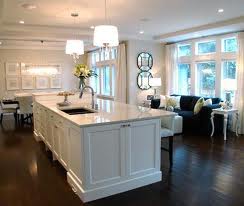White Marble Countertops – You Must Be Joking!
By Nancy June 14th, 2012
We attended a seminar this week on the use and care of white marble in kitchens. It was fascinating, and not only because the presenter looked like Malibu Ken. (It was actually disconcerting to look at him for any length of time, like ones eyes would be scorched by his perfect Ken-likeness. But thankfully the room was dark during the seminar and we were able to concentrate fully on marble.)
 So many people categorically dismiss the idea of white marble in the kitchen. They typically say something like “it stains, it scratches, it’s really expensive and difficult to maintain, so let’s look at granite instead”. That doesn’t exactly make sense. It’s kind of like saying, “I’m trying to lose weight so I’ll skip the ice cream and have cheesecake instead”. Maybe the ice cream would have been the better choice. Or, if you’ve already used all your Weight Watchers points, maybe you should have had an apple.
So many people categorically dismiss the idea of white marble in the kitchen. They typically say something like “it stains, it scratches, it’s really expensive and difficult to maintain, so let’s look at granite instead”. That doesn’t exactly make sense. It’s kind of like saying, “I’m trying to lose weight so I’ll skip the ice cream and have cheesecake instead”. Maybe the ice cream would have been the better choice. Or, if you’ve already used all your Weight Watchers points, maybe you should have had an apple.
Hmmm…
There are three important factors to look for when choosing any natural stone for a countertop surface: its hardness, its absorption rate, and its abrasion resistance. Basically what you’re want to know is how easily will it stain and how easily will it scratch. I’m not going to go into detailed data here about specific absorption rates and the Mohs scale and all that. Just keep in mind that some marble will have lower absorption rates than some granite; some granites are more resistant to etching than some marbles. The main point to take away is that each stone has its own properties and you’d better ask some questions before you put it in your kitchen or bathroom. And you’d better be honest with yourself about maintenance. Find out what’s involved with sealing – you might find that it’s not a big deal. And maybe you just shouldn’t be looking at natural stone.
 There are good reasons to use marble in a kitchen. It’s been used for hundreds of years not only because of the beauty of marble, but because of its thermal properties which keep dough cool. That’s why you see it often in fudge factories and bakeries. A major downside is that it can be etched by acids such as vinegar and lemon juice. (Etching will show up on marble as a dull spot.) Todd, the seminar presenter, showed us Danby marble from Vermont Quarries. (No, he is not NOT named Ken, and he did not come from Malibu. He is Todd from Colorado, and is very knowledgeable about natural stone!) Danby marble has a relatively low absorption rate making it highly suitable for use in kitchens. And with a honed finish, small surface scratches and any acid etching will be less likely to show. Cleaning the countertop is easy, but it’s got to be a pH neutral cleaner. Vermont Quarries says that you can use Comet with Bleach and a Scotch-Brite pad to clean it and buff it up.
There are good reasons to use marble in a kitchen. It’s been used for hundreds of years not only because of the beauty of marble, but because of its thermal properties which keep dough cool. That’s why you see it often in fudge factories and bakeries. A major downside is that it can be etched by acids such as vinegar and lemon juice. (Etching will show up on marble as a dull spot.) Todd, the seminar presenter, showed us Danby marble from Vermont Quarries. (No, he is not NOT named Ken, and he did not come from Malibu. He is Todd from Colorado, and is very knowledgeable about natural stone!) Danby marble has a relatively low absorption rate making it highly suitable for use in kitchens. And with a honed finish, small surface scratches and any acid etching will be less likely to show. Cleaning the countertop is easy, but it’s got to be a pH neutral cleaner. Vermont Quarries says that you can use Comet with Bleach and a Scotch-Brite pad to clean it and buff it up.
Knowledge is power. Knowing the end users maintenance preferences and knowing what questions to ask of the stone selection center are the best places to start in the countertop selection process. There are so many beautiful options available; it would be a shame to categorically rule one out because of misperceptions.

